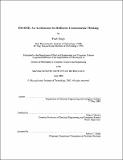EM-ONE : an architecture for reflective commonsense thinking
Author(s)
Singh, Pushpinder, 1972-2006.
DownloadFull printable version (11.04Mb)
Alternative title
Architecture for reflective commonsense thinking
Other Contributors
Massachusetts Institute of Technology. Dept. of Electrical Engineering and Computer Science.
Advisor
Marvin Minsky.
Terms of use
Metadata
Show full item recordAbstract
This thesis describes EM-ONE, an architecture for commonsense thinking capable of reflective reasoning about situations involving physical, social, and mental dimensions. EM-ONE uses as its knowledge base a library of commonsense narratives, each describing the physical, social, and mental activity that occurs during an interaction between several actors. EM-ONE reasons with these narratives by applying "mental critics," procedures that debug problems that exist in the outside world or within EM- ONE itself. Mental critics draw upon commonsense narratives to suggest courses of action, methods for deliberating about the circumstances and consequences of those actions, and--when things go wrong-ways to reflect upon and debug the activity of previously invoked mental critics. Mental critics are arranged into six layers, the reactive, deliberative, reflective, self-reflective, self-conscious, and self-ideals layers. The selection of mental critics within these six layers is itself guided by a separate collection of meta-level critics that recognize what overall problem-type presently confronts the system. EM-ONE was developed and tested within an artificial life domain where simulated robotic actors face concrete physical and social problems. (cont.) A detailed scenario is presented where EM-ONE enables two such actors to work together to build a table by engaging reactive, deliberative, and reflective processes operating across the physical, social, and mental realms.
Description
Thesis (Ph. D.)--Massachusetts Institute of Technology, Dept. of Electrical Engineering and Computer Science, 2005. Includes bibliographical references (leaves 147-152).
Date issued
2005Department
Massachusetts Institute of Technology. Department of Electrical Engineering and Computer SciencePublisher
Massachusetts Institute of Technology
Keywords
Electrical Engineering and Computer Science.